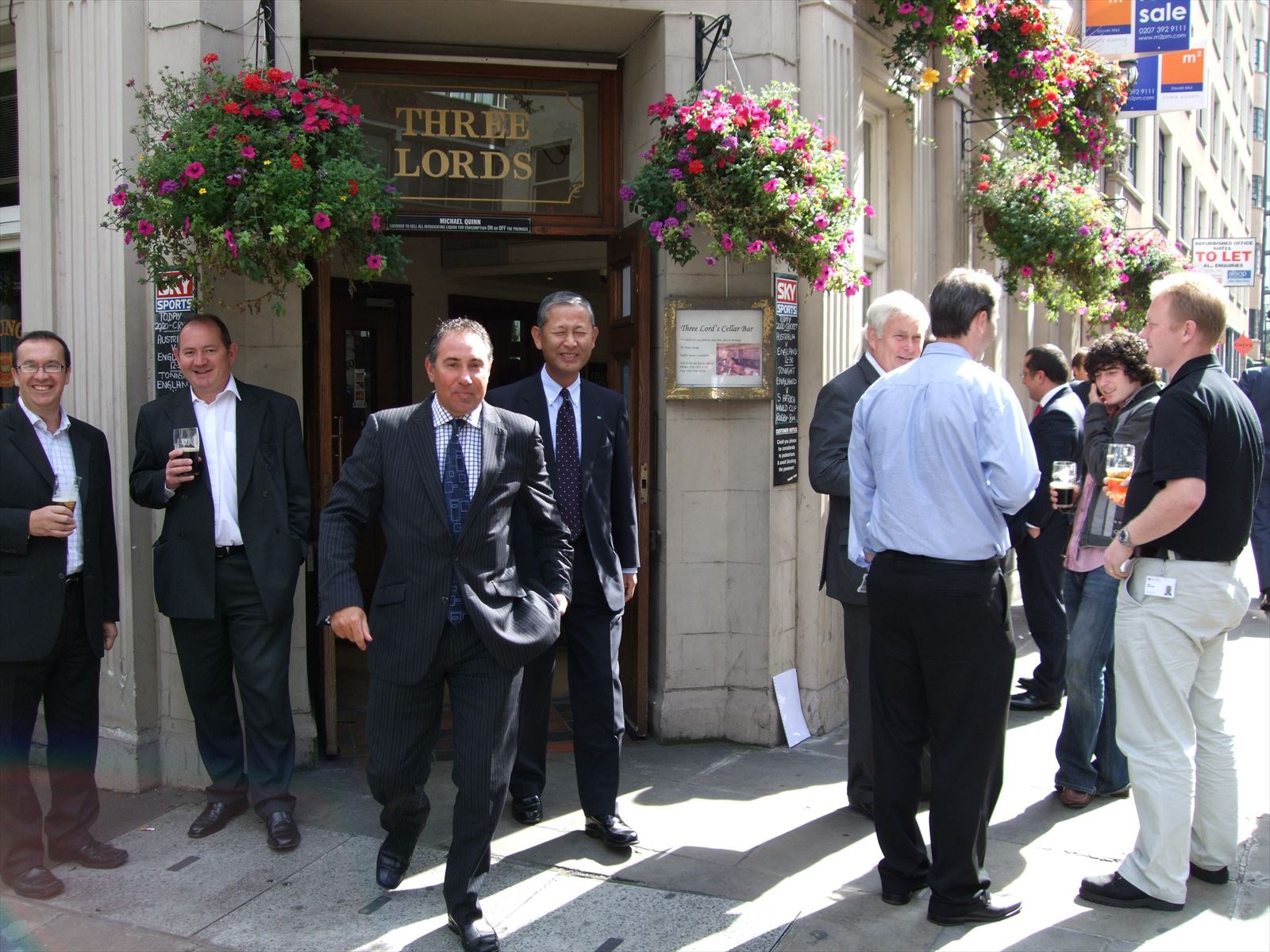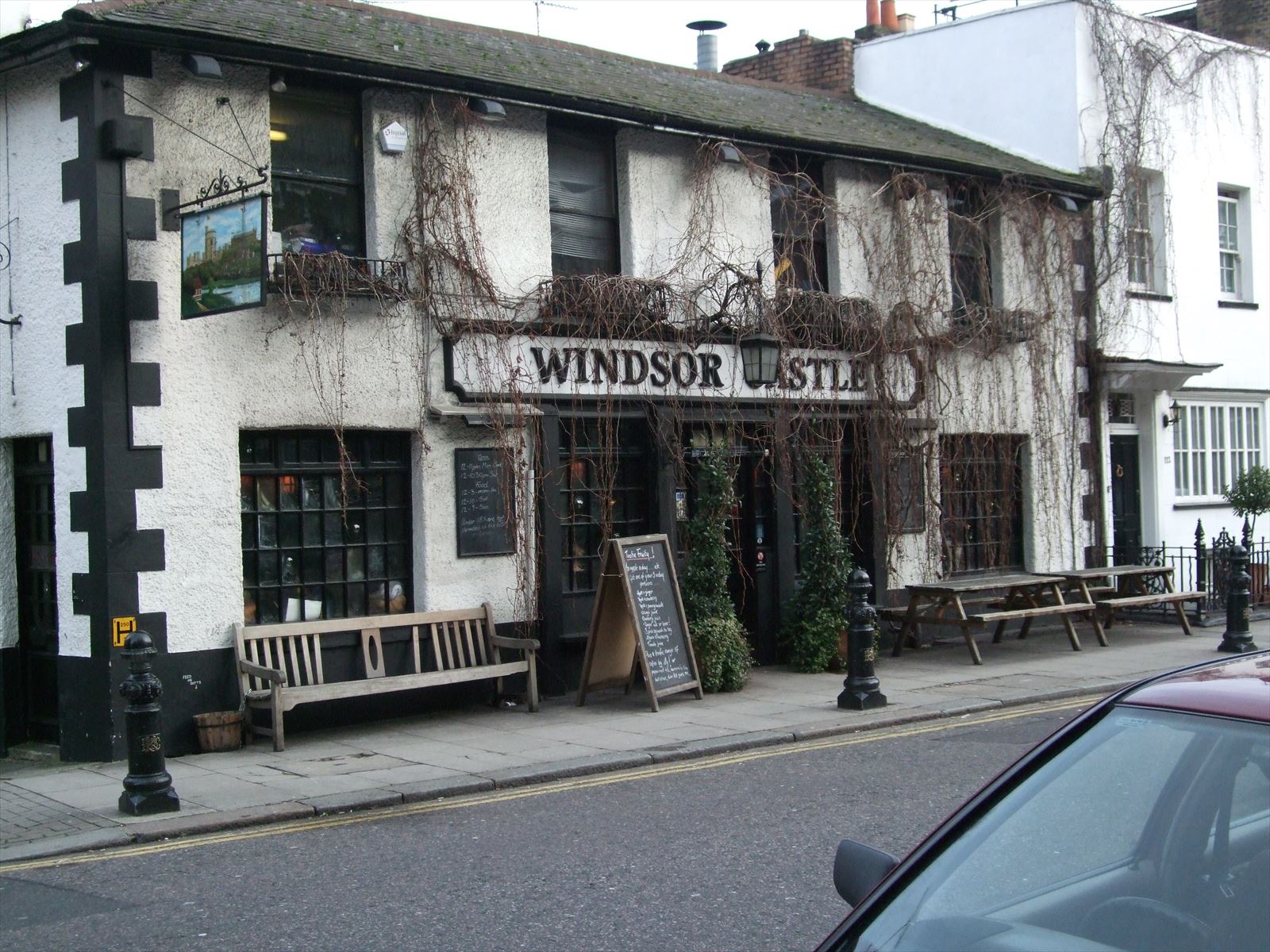リスク対応策 2020.08.29
RM44 コーヒーハウスからパブへ(From Coffee House to Pub)
目次
For those who prefer to read this column in English, the Japanese text is followed by a British English translation, so please scroll down to the bottom of the Japanese text.
最も英国的な食文化は「Pub (パブ)」ではないだろうか、英国中の街や村には必ずと言っていいほどパブがある。日本語の「酒場」や「居酒屋」という言葉に翻訳するとニュアンスがかなり異なってくるため、日本でも「パブ」と呼ばれることが多い。
昔は、ロイズ・コーヒー・ハウス(Lloyd’s Coffee House)がその役目を果たしたが、今ロンドンに出張してロイズ(Lloyd’s of London)や再保険会社のアンダーライター達と話しをする場は、ロイズのなかでも、また彼らがロイズ近くに持っている事務所のなかでもなく、ほとんどの場合パブでおこなうのがロンドンの保険業界の常識である。
午前10時、「ロイズが開く」時間帯から、シティ中のパブが一斉に「保険市場」となる。昔は、手頃な価格で宿泊施設を提供するだけでなく、実は旅人のための替え馬を用意、そのため厩舎も併設していたのがパブである。

1.パブとロンドン
英国内にあるパブは、5万数千軒以上あると言われている。大きなパブでは、ランチタイムや夕方には食事ができるところもあるが、シティの中心にあるような小さなパブ、その多くは300年以上の歴史のあるパブであるが、そのようなパブでは食事の提供は一切されず、当然、つまみもポテトチップス程度しかなく、客のほとんどは、座席が少ないこともあって立ったまま、喋りながら、ビールを「飲み続ける」場所である。
19世紀ビクトリア朝時代に、「パブの萌芽が現れ、『Public House(公共の家)』と呼ばれたものが略されてPub(パブ)となった」とされているが、実はそれ以前からパブの原型は、「旅行者のための安い宿」として存在していた。筆者がロンドンで定宿にしているハイドパーク前のホテル、そこから歩いて5分ほどのところ、ケンジントン宮へ向かう地下鉄の駅、Queensway(クインーズウエイ)駅のすぐ傍のパブによく行く。ある時、ふと窓際から見ると見慣れない小屋があるのに気がついた。ホテルに戻る時、よく見ると今は使われていない「馬屋」であるのが解った。
2.パブの役割
ロンドンに初めて行ったとき、東京と比べて曲線道路が多いと感じた。当時お世話になっていた、またそれ以来ご厚誼を得ている、長くロンドンに在住されていた総合商社の方にこの質問を投げかけると、「それは、馬車がスピードを落とさずに走って行けるようにしたからカーブが多いのですよ」との答えが返ってきた。そう考えて見てみると、有名なものでは、「Regent Hair(リージェント・ヘア)」の名前を生み出した、ロンドン中心部にあるRegent Street(リージェント・ストリート)をはじめ、実に多くの曲線道路があることに改めて気がついた。
19世紀「Public House(公共の家)」と呼ばれたパブは、それ以前は「Inn(イン)」や「Tavern(タヴァン)」等の名称を冠していた。「Inn(イン)」は日本でも宿泊施設にその名前が冠されていることで推察できるが、ローマ時代、ローマ軍が現在の英国の土地を占領して道路をつくったとき、ある一定の距離毎に置かれた宿泊施設に付けられた名前が起源である。「タヴァン」(tavern)は英国の古語とも言える古めかしい表現であるが、なぜか米国では、居酒屋、酒場にこの名称が付けられていることが多い。
1393年、英国王チャールズ2世の命令により、「客商売」の施設にはすべて看板を掲げることが定められた。信仰心が篤かったため、教会への巡礼を奨励、多くの宿も次々につくらせ、宿泊施設にも、当然看板を掲げることを命じた。
読み書きができる人が、ごく少ない時代であったため、文字を書いただけでは理解されないため、どこも商うものを絵柄にして、店先に掲げた。パン屋がパン、靴屋が靴というように。ところが宿泊施設では、この目印になるものがない。提供するビールのジョッキを描いてもどの店も同じになり絵柄では理解されない。そこで、様々な屋号を考えた。昔は、2階が宿泊施設であったこの写真のパブは、屋号を「Windsor Castle(ウインザー城)」に決め、看板にもウインザー城の絵が描かれている。この結果、パブの屋号と看板は実に多種多様なものとなっていったのである。

このチャールズ2世の命令をいまだに守っていると考えられるのが、今では「パブのみ」とも言える、実はパブを見つけるには、写真のような「絵の看板が掛かっているところ」を目安に行けば間違いなくパブにたどり着ける街がロンドンであり、英国中のほとんどの街でもあるからである。
3.パブのリスクマネジメント
ローマ時代からロンドンの政治経済の中心地である、今では「金融街シティ」と呼ばれる、シティ・オブ・ロンドン(City of London)を離れると、どこの街にあるパブも、みな「馬屋」を併設している。鉄道やクルマという移動手段が無かった昔、移動手段は専ら馬であったが、遠出をする場合、考えなければならないことは、電気やガソリンの供給さえあれば、相当な距離を走り続けることができる鉄道やクルマと違って、「馬」には走行距離に限界があるということである。一頭の馬でかなりの距離を移動することは不可能である、まして「速い移動が必要な場合」には、尚更である。実は、パブはそのための「馬を取り替えることができる場所」でもあり、また「公的な連絡を高速でおこなうため替え馬を繋いでおく場所」でもあったのである。
このことを今に残す行事が、毎年、ロンドンのグリニッチ地区で、クリスマス近くになると開かれる。2人1組で馬の着ぐるみをまとって通りを駆け抜ける、クリスマス・チャリティーのためのレースである。様々な色の着ぐるみを着た各チームが道路を走り、途中で「ピット」として数軒のパブに立ち寄りながらゴールを目指すのである。1人が馬の頭をかぶり、もう1人が背中側に入り、通りや狭い路地を進み、小さな障害を飛び越えるようすを大勢の見物客が見守るチャリティー・イベントである。
今回のまとめ
ロンドンの街を歩くと解るが、古くからある馬屋の付いた、「パブ」と「パブ」との間の距離は、ちょうど、馬が歩みを休むべき距離につくられていることが解る。また、現代のロンドンの地下鉄の駅と隣の駅との間が、不思議にもこの距離と重なっている。地下鉄の駅が出来て人々が集まって来たから、地下鉄の駅の近くにパブができたのではなく、逆にパブが出来て人々が集まって暮らし始めた、その地点毎に地下鉄の駅が出来ているとロンドンでは感じる。
リスクマネジメントは、リスクを想定して特定するところからすべてが始まる。馬が蹄で地面を蹴って走る、蹄にはその反作用の力が加わり、そのためにエネルギーが消耗して疲れて走れなくなる。このように、「何かの動きがあった」場合には、その「作用に対して反作用」が必ず起きる、「運動の第3法則」、一般的には「作用・反作用の法則」として知られている、物理学の法則である。その作用と反作用の大きさは等しく,逆向きで,両方を結ぶ直線の方向に働くという法則である。これが万物に起こる法則である。
当然、万物の一部である、人間の行動、その集合体である企業の事業活動、この「作用」があれば、その逆向きに同じ規模のエネルギーを持つ力が「反作用」として起きる。この連関関係を検証する手法がリスクマネジメントである。しかしながら、残念なことに「作用」に対して同程度の力の「反作用(=リスク)」が起きるという、この万物に対して起きる物理学の法則が理解されていないことが多い。
昨今、リスクマネジメントの欠如に起因すると考えられる事件、事故の連鎖を見るにつけ、「キャプティブ」という「作用・反作用によって起きるリスクを検証して対応する手段」の構築を視野にした、本格的なリスクマネジメントが求められる時代に、確かに入ってきたと言えるのではないだろうか。
執筆・翻訳者:羽谷 信一郎
English translation
Risk Management 44 – From Coffee House to Pub
One of the most British aspects of food culture in my opinion is the pub. There is almost always a pub in every town and village in the UK. The Japanese terms “pub” and “izakaya” have a very different nuance when translated into Japanese, and are often referred to as “pub” in Japan as well.
In the past, Lloyd’s Coffee House served that purpose, but now the place where I travel to London to talk to Lloyd’s (Lloyd’s of London) and the reinsurance company underwriters is the place where they, among Lloyd’s, also It is common practice in London’s insurance industry to hold most of their meetings in pubs, not even in the offices they have near Lloyd’s.
From 10AM, when “Lloyd’s (Lloyds of London) opens”, every pub in the City becomes an “insurance market”. In the old days, the pubs not only provided affordable accommodation, but actually had stables for travelers to use as well as a replacement horse.
1.Pubs and London
It is estimated that there are over 50,000 pubs in the UK. Some of the larger pubs serve food at lunchtime and in the evenings, but the smaller pubs, many of which are in the heart of the City, some of which are more than 300 years old, do not serve any food at all, and of course, the nibbles are limited to crisps. It was a place to stand and talk and “continue to drink” beer.
It is said that in the Victorian era of the 19th century, “the germ of the pub appeared, and what was called a ‘public house’ was abbreviated to a pub,” but the prototype of the pub existed even before that as a cheap inn for travelers. I often go to the pub at the hotel in front of Hyde Park where I stay in London, about 5 minutes’ walk from the hotel, which is right next to Queensway tube station to Kensington Palace. One day, I noticed an unfamiliar hut when I looked out of the window. When we returned to the hotel, we found it was a disused ‘stables’.
2.The role of the pub
When I first went to London, I found it to have more curvy roads than Tokyo. When I posed this question to the general trading company I was working for at the time, a long-time London resident, he replied, “because they allow the carriages to go on without slowing down. That’s why there are so many curves. Thinking about it, I realized once again that there are so many curvy roads, including the famous Regent Street in central London, which gave birth to the name “Regent Hair”.
The Public House, as it was called in the 19th century, had earlier been known as the Inn and the Tavern. The Inn, which is presumably the name given to the lodging facilities in Japan as well, originated in Roman times when the Romans occupied what is now Britain and built roads through the area, naming the lodgings at a certain distance from each other. The word “tavern” is an archaic English term, but for some reason taverns and taverns in the U.S. are often called by this name.
In 1393, by order of King Charles II of England, it was decreed that all establishments in the “guest trade” were to carry a sign. His religious beliefs encouraged pilgrimages to churches, and he had many lodgings built, one after another, and of course he ordered all lodgings to have a sign displayed.
As there were very few people who could read and write, they could not be understood just by writing letters, so they put up signs with pictures of their business. A bakery sold bread, a shoemaker sold shoes, and so on. However, lodging establishments did not have these markers. Even if you drew a beer mug, all the shops would look the same and would not be understood by the design. So, we came up with a variety of store names. The pub in this photo, which used to be a lodging facility on the second floor, decided on the name Windsor Castle and the signboard has a picture of Windsor Castle on it. As a result, there was a great variety of pub names and signs.
It can be said that Charles II’s orders are still followed because London, and most cities in Britain, are now “pubs only”; in fact, if you want to find a pub, you can definitely find one by following the signs with pictures, as shown in the picture. .
3.Risk management in pubs
When you leave the City of London, now known as the ‘City of Finance’, the political and economic center of London since Roman times, every pub in every city has a ‘stables’. In the old days, when there were no trains or cars, the means of transport was exclusively by horse. However, if you are going to travel far, you have to think about the fact that unlike trains and cars, which can cover a considerable distance as long as there is electricity and petrol supply, there is a limit to the distance a ‘horse’ can travel. It is impossible for one horse to travel a considerable distance, especially when “fast travel” is required. In fact, the pub was not only a place to change horses for this purpose, but also a place to tie up a replacement horse so that official communications could be carried out at high speed.
The event that preserves this tradition is held every year in the London Borough of Greenwich, near Christmas, when pairs of people dress up in horse costumes and race through the streets for a Christmas charity. Each team, dressed in a variety of colors, runs down the street, stopping at a few pubs along the way as they “pit” for the finish line, one on the horse’s head and the other on his back, making their way through the streets and narrow alleys, jumping over small obstacles for the benefit of a crowd of onlookers.
Summary of this issue
As you walk around London, you will see that the distance between a “pub” and a “pub” with an old stall is exactly the distance a horse should rest its legs. We can see that the distance between the subway station and the next station in London today is strangely similar to this distance. In London, I feel that the Underground station was not built near a station because people came to live there after the subway station was built, but on the contrary, a pub was built and people began to gather and live there, and a subway station is built at each point.
Risk management is all about assuming and identifying risks. A horse kicks the ground with its hooves and runs, its hooves are subjected to the force of the reaction, which drains its energy and makes it too tired to run. Thus, when there is “some motion,” there is always a “reaction to the action,” known as the “third law of motion,” or more commonly as the “law of action and reaction,” which is a law of physics. It is the law that the magnitude of the action and the reaction are equal and opposite in magnitude, and that they act in the direction of a straight line connecting them both. This is the law of what happens to all things.
Naturally, if there is this “action” in a part of all things, the actions of human beings, and the business activities of a company, which is a collection of them, then a force of the same size of energy in the opposite direction will occur as a “reaction”. Risk management is a method for verifying this relationship.
Unfortunately, however, this law of physics, which states that there will be a reaction (or risk) of the same magnitude of force to the action, is not well understood in many cases. In light of the recent string of incidents and accidents that are believed to have been caused by a lack of risk management, it can be argued that we have entered an era in which full-scale risk management with a view to constructing captives, which are means of verifying and responding to risks caused by action and reaction, is now required !!
Author/translator: Shinichiro Hatani

